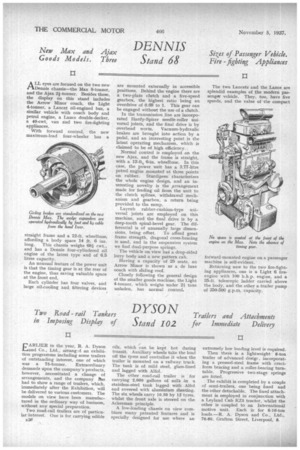DHNNIS
Page 44

If you've noticed an error in this article please click here to report it so we can fix it.
Stand 68
ALLeyes are focused on the two new Dennis chassis—the Max 8-tanner, and the Ajax 2i-tonner. Besides these, the display on this stand includes the Arrow Minor coach, the Bight 4-tonner, a Lancet oil-engined bus, a similar vehicle with coach body and petrol engine, a Lance double-decker, a 40-cwt, van and two fire-fighting appliances.
With forward control, the new maximum-load four-wheeler has a
straight frame and a 12-ft. wheelbase, affording a body space 14 A. 6 ins.
long. This chassis weighs 68i cwt., and has a Dennis four-cylindered oil engine of the latest type and of 6.5 litres capacity.
An unusual feature of the power unit is that the timing gear is at the rear of the engine, thus saving valuable space at the front end.
Each cylinder has four valves, and large oil-cooling and filtering devices are mounted externally in accessible positions. Behind the engine there are a two-plate clutch and a five-speed gearbox, the highest ratio being an overdrive of 0.69 to I. This gear can be engaged without the use of a clutch.
In the transmission line are incorporated Hardy-Spicer needle-roller universal joints, and the final drive is by overhead worm. Vacuum-hydraulic brakes are brought into action by a pedal, and an interesting point is the latest operating mechanism, which, is claimed to be of high efficiency.
Normal control is employed on the new Ajax, and the frame is straight, with a 12-ftt 6-in. wheelbase. In this case, the power unit has a 3.77-litre petrol engine mounted at three points on rubber. Sturtlipess characterizes the whole engine design, and an interesting novelty is the Arrangement made for feeding oil from the unit to the clutch splines, withdrawal mechanism and gearbox, a return being provided to the sump.
Layrub rubber-cushion-type universal joints are employed on this machine, and the final drive is by a deep-tooth spiral-bevel gear. The differential is of unusually large dimensions, being offset. To afford great frame strength, diagonal cross-bracing is used, and in the suspension system we find dual-purpose springs.
The vehicle on view has a drop-sided lorry body and a new pattern cab.
Having a capacity of 25 seats, an Arrow Minor is shown as a de hixe coach with sliding roof.
Closely following the general design of the smaller goods machine, the Light 4-tonner, which weighs under 24 tons unladen, has normal control. The two Lancets and the Lance are splendid examples of the modern passenger vehicle. They, too, have five speeds, and the value of the compact forward-mounted engine on a passenger machine is self-evident.
Returning now to the two fire-fighting appliances, one is a Light 6 fireengine with 100 b.h.p. engine, and a 35-ft. telescopic ladder carried above the body, and the other a trailer pump of 350-500 g.p.m, capacity.


















































































